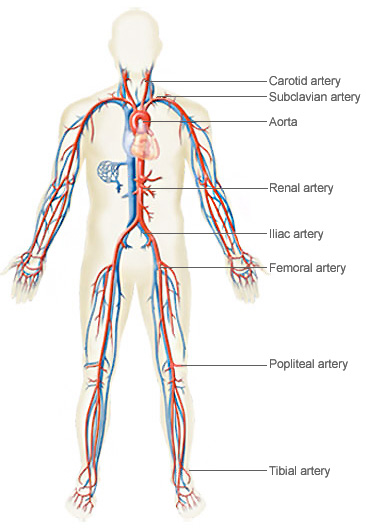Description
Do you have leg pain or trouble walking? Sometimes these problems are thought of as part of getting older. However, such problems may be signs of a serious circulation problem called peripheral artery disease, or PAD.
PAD is a disease of the blood vessels in areas outside the heart. Often, PAD affects the arteries that carry blood to the legs and arms. PAD is also called peripheral vascular disease, or PVD.

- The aorta, your body's largest artery, is attached directly to the left ventricle of your heart. The left ventricle pumps blood out of your heart through the aortic valve into the aorta. All other major arteries branch from the aorta and carry blood to the rest of your body.
- The carotid arteries are the main arteries in your head and neck that supply blood to your brain.
- The subclavian arteries supply blood to your arms.
- The renal arteries supply blood to your kidneys.
- The iliac arteries supply blood to your lower abdomen.
- At the pelvis, the iliac arteries become the femoral arteries, which supply blood to most of your legs.
- At your knees, the femoral arteries become the popliteal arteries, which supply blood to your lower legs.
- At your ankles, the popliteal arteries split into tibial arteries, which supply blood to your feet.
- Globally, 202 million people were living with peripheral artery disease in 2010.1
- It has been estimated that between 4–8% of the Western Europe population 40 years and older has PAD.2
- Lower limb PAD is the 3rd leading cause of atherosclerotic vascular morbidity after coronary heart disease and stroke.2
- Patients with and without leg ischaemic symptoms have roughly a three-fold increase in risk of mortality and major cardiovascular events (heart attack and stroke) compared with those without peripheral artery disease.2















